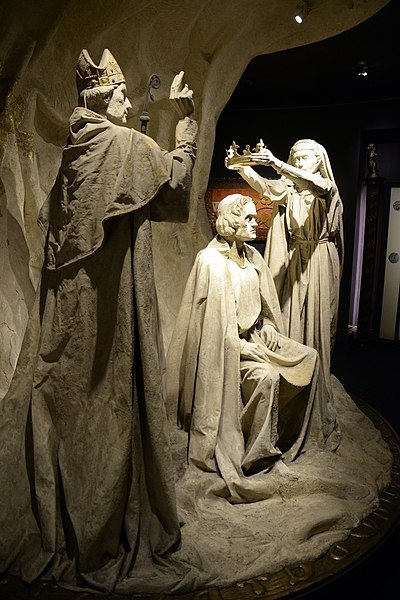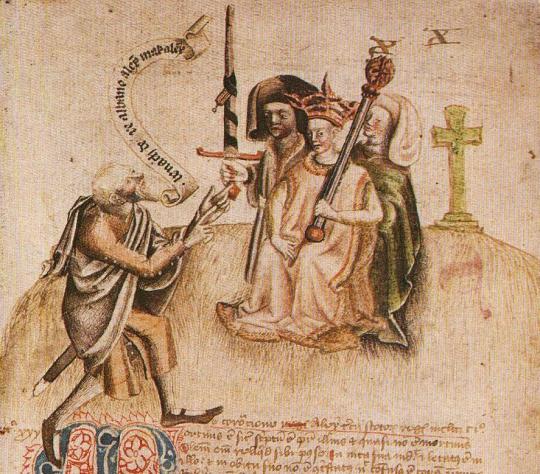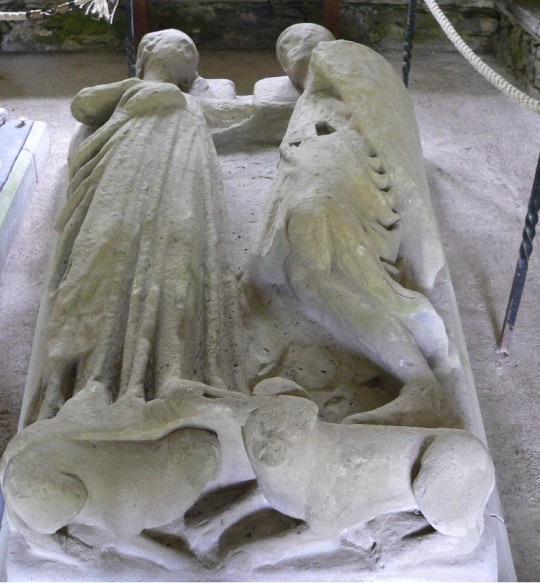#Isabella Countess of Menteith
Text



On the freezing morning of March 25 1306, Robert the Bruce was crowned King of Scots at Scone where a circlet of gold was raised and placed upon his head.
He was crowned in the presence of at least three bishops and four earls with the coronation, which followed the murder of John Comyn, Bruce’s main rival to the throne, a formal and solemn affair.
The King was draped in “kingly robes and vestments” which had been hidden away by Robert Wishart, the Bishop of Glasgow, until “this longed for day”, according to Ronald McNair Scott in his book Robert the Bruce, King of Scotland.
“(They) were brought out by the old man and set upon King Robert, and a circlet of gold was placed upon his head while the great banner of the kings of Scotland with its lion and scarlet lillies, that had lain so long concealed, was planted behind his throne,” the author wrote.
The Bishops of Moray and St Andrews were also in attendance as well as the Earls of Atholl, Lennox, Menteith and Mar. Absent, however, was the Earl of Fife, who held the hereditary right to crown the kings of Scotland.
Still a youth and held in England as a ward of court in 1306, he unable to attend the coronation and perform his hereditary duties. But his sister, 19-year-old Isabella MacDuff, the Countess of Buchan, went against the will of her husband - a loyal supporter of Edward I and close kinsman of the murdered John Comyn - by taking up the hugely symbolic role during the coronation.
“To her the call of Scotland and her youthful hero-worship of Bruce proved greater than her wifely duty,” Scott wrote.
“Seizing her husband’s finest horses, she rode with the upmost speed to Scone to act on her brother’s behalf” he added.
Isabella arrived a day too late but but King Robert took part in a second coronation ceremony, 48 hours after the first,so that the ancient tradition may be preserved.
“The golden circlet was lifted once more and placed upon the brow of Robert Bruce, Earl of Carrick, Lord of Annandale, King of Scots.”
Following the coronation, Edward I sent soldiers into Scotland to hunt down the new king. Robert fled and, as the manhunt continued across Scotland, the King’s brother - Nigel de Brus - and other supporters were discovered.
They were taken to Berwick-Upon-Tweed where the men were judicially condemned, hanged, drawn and beheaded.
Along with other members of the family including King Robert's wife, Elizabeth, Isabella was captured and sent to the Borders town. There, she was confined to a cage that was hung from a tower at Berwick Castle as a warning to others. She remained in the cage for four years, according to accounts.
40 notes
·
View notes
Text
2nd January 1264: Marriage and Murder in Mediaeval Menteith

(Priory of Inchmahome, founded on one of the islands of Lake of Menteith in the thirteenth century)
On 2nd January 1264, Pope Urban IV despatched a letter to the bishops of St Andrews and Aberdeen, and the Abbot of Dunfermline, commanding them to enquire into a succession dispute in the earldom of Menteith. Situated in the heart of Scotland, this earldom stretched from the graceful mountains and glens of the Trossachs, to the boggy carseland west of Stirling and the low-lying Vale of Menteith between Callander and Dunblane. The earls and countesses of Menteith were members of the highest rank of the nobility, ruling the area from strongholds such as Doune Castle, Inch Talla, and Kilbryde. Perhaps the best-known relic of the mediaeval earldom is the beautiful, ruined Priory of Inchmahome, which was established on an island in Lake of Menteith by Earl Walter Comyn in 1238. Walter Comyn was a powerful, if controversial, figure during the reigns of Kings Alexander II and Alexander III. He controlled the earldom for several decades after his marriage to its Countess, Isabella of Menteith, but following Walter’s death in 1258 his widow was beset on all sides by powerful enemies. These enemies even went so far as to capture Isabella and accuse her of poisoning her husband. The story of this unfortunate countess offers a rare glimpse into the position of great heiresses in High Mediaeval Scotland, revealing the darker side of thirteenth century politics.
Alexander II and Alexander III are generally remembered as powerful monarchs who oversaw the expansion and consolidation of the Scottish realm. During their reigns, dynastic rivals like the MacWilliams were crushed, regions such as Galloway and the Western Isles formally acknowledged Scottish overlordship, and the Scottish Crown held its own in diplomacy and disputes with neighbouring rulers in Norway and England. Both kings furthered their aims by promoting powerful nobles in strategic areas, but it was also vital to harness the ambition and aggression of these men productively. In the absence of an adult monarch, unchecked magnate rivalry risked destabilising the realm, as in the years between 1249 and 1262, when Alexander III was underage.

(A fifteenth century depiction of the coronation of Alexander III. Source: Wikimedia Commons)
Walter Comyn offers a typical picture of the ambitious Scottish magnate. Ultimately loyal to the Crown, his family loyalties and personal aims nonetheless made him a divisive figure. A member of the powerful Comyn kindred, he had received the lordship of Badenoch in the Central Highlands by 1229, probably because of his family’s opposition to the MacWilliams. In early 1231, he was granted the hand of a rich heiress, Isabella of Menteith. In the end, there would be no Comyn dynasty in Menteith: Walter and Isabella had a son named Henry, mentioned in a charter c.1250, but he likely predeceased his father. Nevertheless, Walter Comyn carved out a career at the centre of Scottish politics and besides witnessing many royal charters, he acted as the king’s lieutenant in Galloway in 1235 and became embroiled in the scandalous Bisset affair of 1242.
When Alexander II died in 1249, Walter and the other Comyns sought power during the minority of the boy king Alexander III. They were opposed by the similarly ambitious Alan Durward and in time Henry III of England, the attentive father of Alexander III’s wife Margaret, was also dragged into the squabble as both sides solicited his support in order to undermine their opponents. Possession of the young king’s person offered a swift route to power, and, although nobody challenged Alexander III’s right to the throne, some took drastic measures to seize control of government. Walter Comyn and his allies managed this twice, the second time by kidnapping the young king at Kinross in 1257. They were later forced to make concessions to enemies like Durward but, with Henry III increasingly distracted by the deteriorating political situation in England, the Comyns held onto power for the rest of the minority. However Walter only enjoyed his victory for a short while: by the end of 1258, the Earl of Menteith was dead.
Walter Comyn had dominated Scottish politics for a decade, and even if, as Michael Brown suggests, his death gave the political community some breathing space, this also left Menteith without a lord. As a widow, Countess Isabella theoretically gained more personal freedom, but mediaeval realpolitik was not always consistent with legal ideals. In thirteenth century Scotland, the increased wealth of widows made them vulnerable in new ways (not least to abduction) and, although primogeniture and the indivisibility of earldoms were promoted, in reality these ideals were often subordinated to the Crown’s need to reward its supporters. Isabella of Menteith was soon to find that her position had become very precarious.

At first, things went well. Although one source claims that many noblemen sought her hand, Isabella made her own choice, marrying an English knight named John Russell. Sir John’s background is obscure but, despite assertions that he was low born, he had connections at the English court. Isabella and John obtained royal consent for their marriage c.1260, and the happy couple also took crusading vows soon afterwards.
But whatever his wife thought, in the eyes of the Scottish nobility John Russell cut a much less impressive figure than Walter Comyn. The couple had not been married long before a powerful coterie of nobles descended on Menteith like hoodie-crows. Pope Urban’s list of persecutors includes the earls of Buchan, Fife, Mar, and Strathearn, Alan Durward, Hugh of Abernethy, Reginald le Cheyne, Hugh de Berkeley, David de Graham, and many others. But the ringleader was John ‘the Red’ Comyn, the nephew of Isabella of Menteith’s deceased husband Walter, who had already succeeded to the lordship of Badenoch. Even though Menteith belonged to Isabella in her own right, Comyn coveted his late uncle’s title there. Supported by the other lords, he captured and imprisoned the countess and John Russell, and justified this bold assault by claiming that the newlyweds had conspired together to poison Earl Walter. It is unclear what proof, if any, John Comyn supplied to back up his claim, but the couple were unable to disprove it. They were forced to surrender all claims to Isabella’s dowry, as well as many of her own lands and rents. A surviving charter shows that Hugh de Abernethy was granted property around Aberfoyle about 1260, but it seems that the lion’s share of the spoils went to the Red Comyn, who secured for himself and his heirs the promise of the earldom of Menteith itself.
Isabella and her husband were only released when they promised to pass into exile until they could clear their names before seven peers of the realm. John Russell’s brother Robert was delivered to Comyn as security for their full resignation of the earldom. Having ‘incurred heavy losses and expenses’, which certainly stymied their crusading plans, they fled.

In a letter of 1264, Pope Urban IV described the couple as ‘undefended by the authority of the king, while as yet a minor’. However, though Alexander III was technically underage in 1260, he was now nineteen and could not be ignored entirely. Michael Brown suggests that Isabella and her husband may have been seized when the king was visiting England, and that John Comyn’s unsanctioned bid for the earldom of Menteith may explain why Alexander cut short his stay in November 1260 and hastily returned north, leaving his pregnant queen with her parents at Windsor. Certainly, Comyn was forced to relinquish the earldom before 17th April 1261. But instead of restoring Menteith to its exiled countess, Alexander settled the earldom on another rising star: Walter ‘Bailloch’ Stewart, whose wife Mary had a claim to Menteith.
Mary of Menteith is often described as Isabella’s younger sister, although contemporary sources never say so and some historians argue that they were cousins. Either way, Alexander’s decision to uphold her claim was probably as much influenced by her husband’s identity as her alleged birth right. Like Walter Comyn, Walter Bailloch (‘freckled’), belonged to an influential family as the brother of Alexander, Steward of Scotland. From their origins in the royal household, the Stewarts became major regional magnates, assisting royal expansion in the west. The promising son of a powerful family, Walter Bailloch was sheriff of Ayr by 1264 and likely fought in the Battle of Largs in 1263. In 1260 Alexander III had the opportunity to secure Walter’s loyalty as the royal minority drew to a close. Conversely John Comyn of Badenoch found himself out of favour and was removed as justiciar of Galloway following the Menteith incident. The king would not alienate the Comyns permanently, but for now, the stars of Walter Bailloch and Mary of Menteith were in the ascendant.

(Loch Lubnaig, in the Trossachs, another former possession of the earls of Menteith)
Isabella of Menteith and John Russell had not been idle in the meantime. Travelling to John’s home country of England, they probably appealed to Henry III. In September 1261, the English king inspected documents relating to a previous dispute over the earldom of Menteith. On that occasion, two brothers, both named Maurice, had their differences settled before the future Alexander II at Edinburgh in 1213. The elder Maurice, who held the title Earl of Menteith and was presumed illegitimate by later writers (though this is never stated), resigned the earldom, which was regranted to Maurice junior. In return the elder Maurice received some towns and lands to be held for his lifetime only, and the younger Maurice promised to provide for the marriage of his older brother’s daughters.
It is probable that Isabella was the daughter of the younger Maurice, and that she produced these charters as proof of her right to the earldom. Perhaps Mary was her younger sister, but it seems likelier that Isabella would have wanted to prove the younger Maurice’s right if Mary was a descendant of the elder brother, and therefore her cousin. However despite Henry III’s formal recognition of the settlement, he did not provide Isabella with any real assistance: for whatever reason, the English king was either unable or unwilling to press his son-in-law the King of Scots on this matter. Isabella then turned instead to the spiritual leader of western Europe- Pope Urban IV.

(A depiction of the coronation of Henry III of England, though in fact the English king was only a child when he was crowned. Source: Wikimedia Commons)
A long epistle which the pope sent to several Scottish prelates in January 1264 has survived, revealing much about the case. Thus we learn that Urban was initially moved by Isabella and her husband’s predicament, perhaps especially so since they had taken the cross. Accordingly, he had appointed his chaplain Pontius Nicholas to enquire further and discreetly arrange the couple’s restoration. Pontius was to journey to Menteith, ‘if he could safely do so, otherwise to pass personally to parts adjacent to the said kingdom, and to summon those who should be summoned’. But Pontius’ mission only hindered Isabella’s suit. According to Gesta Annalia I, the papal chaplain got no closer to Scotland than York. From there he summoned many Scottish churchmen and nobles to appear before him, and even the King of Scots himself. This merely antagonised Alexander III and his subjects. Although Alexander maintained good relations with England and the papacy throughout his reign, he had a strong sense of his own prerogative and did not appreciate being summoned to answer for his actions, especially not outwith his realm and least of all in York. Special daughter of the papacy or not, Scotland’s clergy and nobility supported their king and refused to compear. Faced with this intransigence, Pontius Nicholas placed the entire kingdom under interdict, at which point Alexander retaliated by writing directly to the chaplain’s boss, demanding Pontius’ dismissal from the case.
Urban IV swiftly backpedalled. In a conciliatory tone he claimed that Pontius was guilty of ‘exceeding the terms of our mandate’ and causing ‘grievous scandal’. To remedy the situation, and avoid endangering souls, the pope discharged his responsibility over the case to the bishops of St Andrews and Aberdeen, and the Abbot of Dunfermline. Thus the pope washed his hands of a troublesome case, the Scottish king’s nose could be put back in joint, and Isabella’s suit was transferred to men with great experience of Scottish affairs, who should have been capable of satisfactorily resolving the matter. However, there is no indication that Isabella was ever compensated for the loss of her inheritance, and when the dispute over Menteith was raised again ten years later, the countess was not even mentioned (probably she had since died). Possibly her suit was discreetly buried after it was transferred to the Scottish clerics, a solution which, however frustrating for the exiled countess, would have been convenient for the great men whose responsibility it was to ensure justice was done.

(Doune Castle- the earliest parts of this famous stronghold probably date to the days of the thirteenth century earls of Menteith, although much of the work visible today dates from the late fourteenth and early fifteenth centuries)
The Comyns could not be dismissed so easily. Never resigned to losing Menteith, John Comyn of Badenoch claimed the earldom again c.1273, on behalf of his son William Comyn of Kirkintilloch. William had since married Isabella Russell, daughter of Isabella of Menteith by her second husband.* The 1273 suit was unsuccessful but William Comyn and Isabella Russell did not lose hope, and in 1282, William asked Edward I of England to intercede for them with the king of Scots. In 1285, with William’s father John Comyn long dead, Alexander III finally offered a compromise. Walter Bailloch, whose wife Mary may have died, was to keep half the earldom and he and his heirs would bear the title earl of Menteith. William Comyn and Isabella Russell received the other half in free barony, and this eventually passed to the offspring of Isabella’s second marriage to Sir Edward Hastings. Perhaps this could be seen as a posthumous victory for Isabella Russell’s late parents, but their descendants would never regain the whole earldom (except, controversially, when the younger Isabella’s two sons were each granted half after Edward I forfeited the current earl for supporting Robert Bruce).
Conversely, Walter Bailloch’s descendants remained at the forefront of Scottish politics. He and his wife Mary accompanied Alexander III’s daughter to Norway in 1281, and Walter was later a signatory to both the Turnberry Band and the Maid of Norway’s marriage negotiations. He also acted as a commissioner for Robert Bruce (grandfather to the future king) during the Great Cause. He had at least three children by Mary of Menteith and their sons took the surname Menteith rather than Stewart. The descendants of the eldest son, Alexander, held the earldom of Menteith until at least 1425. The younger son, John, became infamous as the much-maligned ‘Fause Menteith’ who betrayed William Wallace, although he later rose high in the service of King Robert I. Walter Bailloch himself died c.1294-5, and was buried next to his wife at the Priory of Inchmahome on Lake of Menteith, which Walter Comyn had founded over fifty years previously. The effigies of Walter Bailloch and Mary of Menteith can still be seen in the chapter house of the ruined priory: the worn faces are turned towards each other and each figure stretches out an arm to embrace their spouse in a lasting symbol of marital affection.

(The effigies of Walter Bailloch and Mary of Menteith at Inchmahome Priory, which was founded by Walter Comyn in 1238 and was perhaps intended as a burial site for himself and his wife Isabella of Menteith. Source: Wikimedia Commons).
The dispute over Menteith saw a prominent noblewoman publicly accused of murder and exiled, and even sparked an international incident when Scotland was placed under interdict. For all this, neither Isabella of Menteith nor John Comyn of Badenoch triumphed in the long term. Even Walter Bailloch eventually had to accept the loss of half the earldom after holding it for over twenty years. In the end the only real winner seems to have been the king. Although at first sight the persecution of Isabella and her husband looks like a classic example of overmighty magnates taking advantage of a breakdown in law and order during a royal minority, Alexander III was not a child and his rebuke of John Comyn did not result in any backlash against the Crown. Most of the Scottish nobility fell back in line once the king came of age, but the king in turn had to ensure that he was able to reward key supporters if he wanted to expand the realm he had inherited. Although it was important to both Alexander III and his father that primogeniture and were accepted by their subjects as the norm, in practice both kings found that they had to bend their own rules to ensure that the system worked to their own advantage. The thirteenth century is often seen an age of legal development and state-building, but these things sometimes came into conflict with each other, and even the most successful kings had to work within a messy system and consider the competing loyalties and customs of their subjects.
Selected Bibliography:
- “Vetera Monumenta Hibernorum et Scotorum”, Augustinus Theiner (a printed version of Urban IV’s original Latin epistle may be found here)
- “John of Fordun’s Chronicle of the Scottish Nation”, vol. 2, ed. W.F. Skene (this is an English translation of the chronicle of John of Fordun, made when Gesta Annalia I was still believed to be his work. It provides an independent thirteenth or fourteenth century Scottish account of the Menteith case
- “The Red Book of Menteith”, volumes 1+2, ed. Sir William Fraser
- “Calendar of Documents Relating to Scotland, Preserved Among the Public Records of England”, volumes 1, 2, 3 & 5, ed. Joseph Bain
- “The Political Role of Walter Comyn, earl of Menteith, during the Minority of Alexander III of Scotland”, A. Young, in the Scottish Historical Review, vol.57 no.164 part 2 (1978).
- “Scotland, England and France After the Loss of Normandy, 1204-1296″, M.A. Pollock
- “The Wars of Scotland, 1214-1371″, Michael Brown
As ever if anyone has a question about a specific detail or source, please let me know! I have a lot of notes for this post, so hopefully I should be able to help!
#Scottish history#Scotland#British history#thirteenth century#women in history#Menteith#earldom of Menteith#Isabella Countess of Menteith#John Russell#John Comyn I of Badenoch#Alexander III#Henry III#Pope Urban IV#Walter Bailloch#the Stewarts#House of Dunkeld#House of Canmore#Mary of Menteith#inchmahome priory
13 notes
·
View notes
Text
I’m supposed to be researching and writing a post on the unfortunate experiences of Isabella, Countess of Menteith and her English husband John Russel, but to my brain it also just seems like a really good opportunity to correct and edit a five year old post on Mary of Guelders for the hundredth time
#In all fairness Maria van Egmond was pretty dope#And I hate that my post isn't 100% perfect#Even though I learn all the time so how could it be#Nope constant editing is the only way forward#Especially since I'm very excited by the history of Guelders right now
2 notes
·
View notes
Photo

On the freezing morning of March 25 1306, Robert the Bruce was crowned King of Scots at Scone where a circlet of gold was raised and placed upon his head.
He was crowned in the presence of at least three bishops and four earls with the coronation, which followed the murder of John Comyn, Bruce’s main rival to the throne, a formal and solemn affair.
The King was draped in “kingly robes and vestments” which had been hidden away by Robert Wishart, the Bishop of Glasgow, until “this longed for day”, according to Ronald McNair Scott in his book Robert the Bruce, King of Scotland.
“(They) were brought out by the old man and set upon King Robert, and a circlet of gold was placed upon his head while the great banner of the kings of Scotland with its lion and scarlet lillies, that had lain so long concealed, was planted behind his throne,” the author wrote.
The Bishops of Moray and St Andrews were also in attendance as well as the Earls of Atholl, Lennox, Menteith and Mar. Absent, however, was the Earl of Fife, who held the hereditary right to crown the kings of Scotland.
Still a youth and held in England as a ward of court in 1306, he unable to attend the coronation and perform his hereditary duties. But his sister, 19-year-old Isabella MacDuff, the Countess of Buchan, went against the will of her husband - a loyal supporter of Edward I and close kinsman of the murdered John Comyn - by taking up the hugely symbolic role during the coronation.
“To her the call of Scotland and her youthful hero-worship of Bruce proved greater than her wifely duty,” Scott wrote.
“Seizing her husband’s finest horses, she rode with the upmost speed to Scone to act on her brother’s behalf” he added.
Isabella arrived a day too late but but King Robert took part in a second coronation ceremony, 48 hours after the first,so that the ancient tradition may be preserved.
“The golden circlet was lifted once more and placed upon the brow of Robert Bruce, Earl of Carrick, Lord of Annandale, King of Scots.”
Following the coronation, Edward I sent soldiers into Scotland to hunt down the new king. Robert fled and, as the manhunt continued across Scotland, the King’s brother - Nigel de Brus - and other supporters were discovered.They were taken to Berwick-Upon-Tweed where the men were judicially condemned, hanged, drawn and beheaded.
After Bruce’s defeat at the Battle of Methven in June, Isabella was captured with Edward I also sending her to the Borders town. There, she was confined to a cage that was hung from a tower at Berwick Castle as a warning to others. She remained in the cage for four years, according to accounts.
51 notes
·
View notes